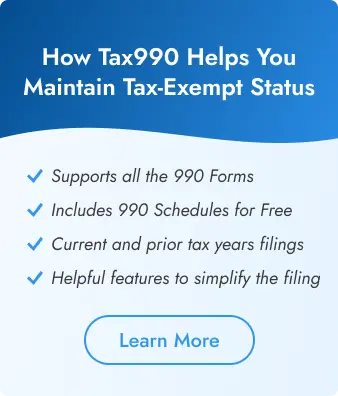Nonprofit organizations that obtained tax-exempt status from the IRS are required to file 990 series forms every year based on gross receipts and primary source of funding to report their financial information, activities, and members’ details to the IRS. Failing to do so for a year will lead to penalties.
If an organization fails to file Form 990 consecutively, it may lead to automatic revocation. This article discusses everything tax-exempt organizations should know about automatic revocation.
Table of Contents
When Does Automatic Revocation Occur?
Automatic Revocation occurs when an exempt organization fails to file an annual return (Form 990, 990-EZ, 990-N, or 990-PF) for three consecutive years. With automatic revocation, the organization's tax-exempt status will be automatically revoked under the law.
This is not applicable to Churches, Conventions or Associations of churches, and Integrated auxiliaries of Churches since they aren’t required to file 990 forms.
How Automatic Revocation Impacts Tax-Exempt Organizations?
The organization will no longer be exempt from federal income taxes.
The IRS will remove the organization’s name from the list of tax-exempt organizations.
The organization will no longer be eligible for tax-deductible contributions.
The State and local laws may also have an impact on an organization that lost its tax-exempt status.
The organization may also be required to file one of the following federal income tax returns and pay the applicable income taxes:
Form 1120 - U.S. Corporation Income Tax Return
Form 1041 - U.S. Income Tax Return for Estates and Trusts
How to Know If the Organization’s Tax-Exempt Status has
been Revoked?
There are two ways to find out if an organization’s tax-exempt status has been revoked:
Notice:
The IRS sends a letter to the organization’s address stating that its exempt status has been automatically revoked since it has not filed 990 returns for three consecutive years.
The letter will include the basic details of the organizations and the effective date of revocation.
Auto-Revocation list:
Every month, the IRS publishes a list of organizations whose federal tax-exempt status has been revoked. The list comprises the following details:
Organization's name
Employer Identification Number (EIN)
Type of exemption
Last known address of the organization
Effective date of revocation
The date the organization's name was posted on IRS.gov.
Reinstating Tax-Exempt Status
If an organization wants to reinstate its tax-exempt status after automatic revocation, it must make an application for exemption and pay the necessary user fee (even if it was not obliged to apply for exempt status in
the first place).
Based on the type of return required to be filed by the organization and the time when the reinstatement is being requested, the reinstatement process varies as follows:
Streamlined retroactive reinstatement process (Form 990-EZ and Form 990-N):
Retroactive reinstatement process (within 15 months)
Retroactive reinstatement process (after 15 months)
Post-mark date reinstatement
Streamlined retroactive reinstatement process
Applicable for organizations that were required to file Form 990-EZ or Form 990-N during the three-year period before automatic revocation and haven’t had their tax-exempt status revoked previously.
These organizations can reinstate their tax-exempt status retroactively to the date of revocation by filing Form 1023, Form 1023-EZ, Form 1024, or Form 1024-A and pay the relevant user fee within 15 months from the organization's Revocation date.
Retroactive reinstatement process (within 15 months)
Applicable for organizations that were required to file Form 990 or Form 990-PF during the three-year period before automatic revocation and for organizations that had their tax-exempt status revoked previously.
These organizations can reinstate their tax-exempt status by:
- Filing Form 1023, Form 1024, or Form 1024-A within 15 months from the organization's revocation date as mentioned in the letter or the auto-revocation list.
- Attaching a reasonable cause statement that describes a legitimate reason for failing to file the annual return for at least one of the three consecutive years.
Retroactive reinstatement process (after 15 months)
The organizations are required to provide a declaration with the reasonable cause of failure for all three years along with filing Form 1023, Form 1024, or Form 1024-A
Post-mark date reinstatement:
Instead of retroactive reinstatement, organizations can apply for reinstatement effective from the post-mark date of their application by filing Form 1023, Form 1023-EZ, Form 1024, or Form 1024-A and paying the applicable user fee.
How Does Reinstatement Work?
After receiving the reinstatement request, if the IRS concludes that the organization fulfills the standards for tax-exempt status:
A new determination letter will be issued to the organization.
The reinstated organization will be added to the list of tax-exempt organizations (Pub. 78 databases).
Indicates that the organization is eligible to receive tax-deductible donations in the IRS Business Master File (BMF) extract.
Erroneous Automatic Revocation
If an organization has filed the 990 returns annually without fail and had their tax-exempt status revoked by mistake, they can contact the IRS Consumer Account Services at (877) 829-5500 for further assistance.
File your 990 Returns on Time with Tax 990 and Avoid Automatic Revocation
Preparing and filing your nonprofit tax returns can be challenging. Tax 990’s exclusive features allow you to file 990 forms easily and securely.
Here is how the IRS-authorized e-filing solution provides you with a hassle-free filing experience:
Auto-Generation of Applicable Schedules
Our system will automatically include the required Schedules for free based on the information
you provide.
Multiple Form Preparation Options
You can prepare your forms with complete ease using our Form-Based or Interview-Style filing options.
Internal Audit Check
By auditing your forms for IRS errors, our built-in error check system ensures accurate returns.
Re-transmission of Rejected Forms
If your form is rejected for any IRS errors, you can fix the errors and re-transmit for free.
Live Customer Support
Our US-based support team is available via live chat, phone, and email to resolve your questions instantly.
Maintain your tax-exempt status by e-filing with Tax 990.

